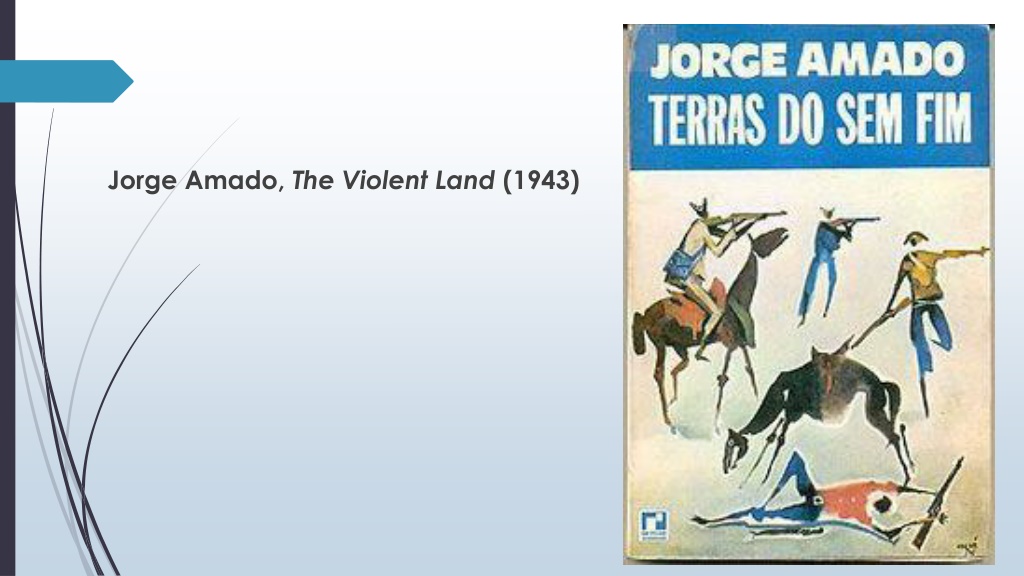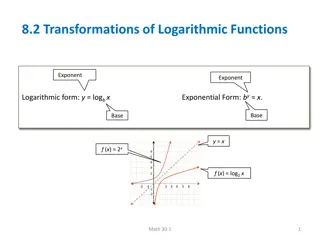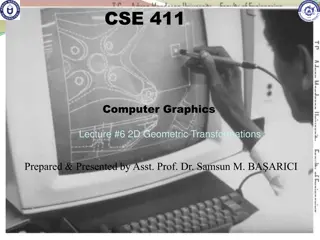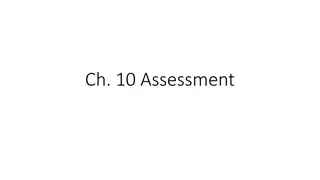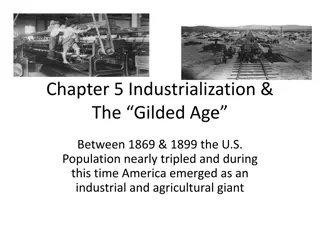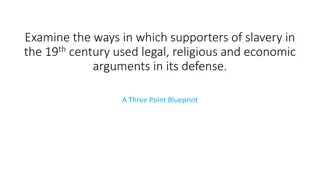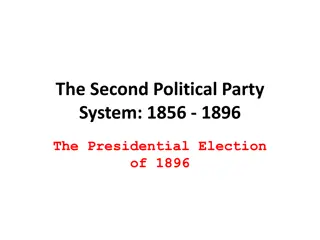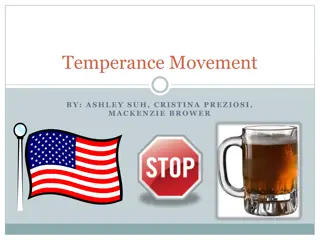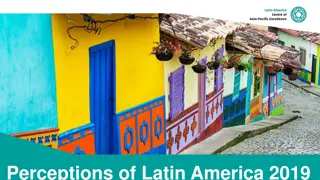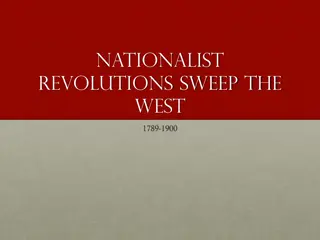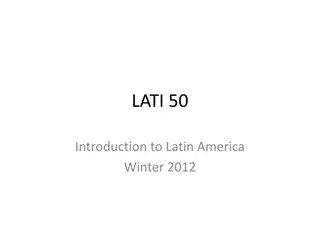Economic Transformations in Latin America during the Late 19th Century
The late 19th century in Latin America marked a period of significant economic changes driven by a global context that included events like the Great Depression of 1873-1896 and the second industrial revolution. Core capitalist powers sought cheap raw materials, labor, and new markets, leading to increased demand for agricultural commodities and industrial crops. The era witnessed a boom in exports driven by the consolidation of liberal regimes in Latin America.
Download Presentation

Please find below an Image/Link to download the presentation.
The content on the website is provided AS IS for your information and personal use only. It may not be sold, licensed, or shared on other websites without obtaining consent from the author. Download presentation by click this link. If you encounter any issues during the download, it is possible that the publisher has removed the file from their server.
E N D
Presentation Transcript
Maranho Piau Cear Rio Grande do Norte Para ba Pernambuco Alagoas Sergipe Bahia
1 Meio-Norte 2 Sert o 3 Agreste 4 Zona da Mata
The Portuguese first imported Africans as slaves to Salvador da Bahia from Guinea in 1538. Legal slavery lasted three and a half centuries. Brazil absorbed approximately forty percent of the entire volume of the trans- Atlantic slave trade (the region that would become the United States, by contrast, absorbed less than five percent). Salvador da Bahia developed into one of the top slave-receiving ports of all time. Between 3.5 and five million African slaves entered Brazil between 1538 and 1850, when imports were banned by international treaty. Approximately 1.2 million enslaved Africans passed through the Bay of All Saints that is, between a quarter and one third of Brazil s total intake of foreign slaves, and nearly ten percent of the volume of the whole trans-Atlantic slave trade. No other single port in history has absorbed and processed so many enslaved human beings. Walker, 'Slave Labor and Chocolate in Brazil: The Culture of Cacao Plantations in Amazonia and Bahia (17th-19th Centuries)', Food and Foodways 15:1 (2007): 75-106
The late 19th century in Latin America the global context: Great Depression of 1873-1896 response of core capitalist powers = mix of productivity and plunder second industrial revolution of late 19th century ratcheting up of colonial domination / imperialist incursions as core capitalist powers sought out cheap raw materials, labour, and new markets; increasingly rapid industrialization generated an accelerated demand for agricultural commodities of all kinds, with a particular burst of expansion from the 1870s onwards [. . .] As well as a new scale of international demand for grains, sugar, tea, coffee, tobacco and bananas, there was an even greater expansion of demand for crops associated with industrial processing and manufacturing, such as vegetable oils, cotton, sisal, jute and rubber (Brass and Bernstein, Introduction: Proletarianisation and deproletarianisation on the colonial plantation , Journal of Peasant Studies, 19:3-4 (1992): 4)
Demand for raw materials prompts an export boom in Latin America 1870 1930 the export age Ericka Beckman: During the last quarter of the nineteenth century, the consolidation of liberal regimes in Latin America resulted in the creation of export driven economies, organized around the production of a handful of commodities for the global market (Capital Fictions, p. 9) [the] world was turned upside down during the export boom, as everything became open to question and subject to power. Even such apparently immutable verities as time and geography were contorted and realigned. The strict discipline and linearity of the clock challenged the more forgiving and circular flow of the natural seasons; the iron rail and the telegraph brought far- flung elites into closer contact with one another than they were with much more physically proximate but culturally distant peoples. (Topik and Wells, The Second Conquest of Latin America, p. 2
Cocoa production did not accelerate toward a truly large scale until the 1890s. Expansion in Brazil responded to the shift in demand in the new century toward the ordinary grades of cocoa that Brazil along with West Africa produced for milk chocolate (Wickizer, 1951), which was only invented in 1879 by Nestle among others. [. . .] In 1937, Brazil s total cocoa production reached a peak of 138,000 tons and then declined until the mid-1940s The best cocoa land in Bahia was often cleared by squatters who were then dispossessed of the land by large landowners, often through violence, swindles, and manipulation of the law. Some large landowners of the boom period had begun as small holders, but others traced family roots to slave-owning estate owners long before the cacao boom, going back even to owners of large sugar mills. By the 1910s, fewer than 20 families probably dominated cacao production in Ilheus, the most important municipality for cacao growing in Bahia. Leiter and Harding, Trinidad, Brazil, and Ghana: three melting moments in the history of cocoa , Journal of Rural Studies, 20 (2004): 113-130
Literary Form and the Frontier: realism requires a conviction as to the massive weight and persistence of the present as such, and an aesthetic need to avoid recognition of deep structural social change as such To acknowledge the imminence of some thoroughgoing revolution in the social order itself, is at once to disqualify those materials of the present which are the building blocks of narrative realism, for from the revolutionary perspective they become mere appearances or epiphenomena, transitory moments of history (Fredric Jameson, A Note on Literary Realism in Conclusion in Adventures in Realism. Ed. Matthew Beaumont (2007), p. 263).
Michael Lwysconcept of critical irrealism for L wy, irrealismdesignates not the opposite of realism, but rather the absence of realism . An irrealist literary work might include elements of fantasy, the oneiric, and the surreal; it may well be founded on a logic of the imagination, of the marvellous, of the mystery or the dream (Michael L wy, The Current of Critical Irrealism in Adventures in Realism (2007), pp. 194-95).
Werner Sombart: If he is a specially able type of speculating undertaker, he may possibly possess the poet s gift of calling up to the minds of his audience ravishing pictures of realms of gold, in order to show the marvels he is capable of producing (The Quintessence of Capitalism, p. 92) a poetics of capital in Latin America, one I call export reverie . This mode emerges as the waking dream of nineteenth-century liberal visionaries, providing beautiful visions of national and regional wealth before it had actually materialized. Characterized by optimism, ebullience, and effervescence, this discourse flourished especially at the dawn of the Export Age in the 1870s and 1880s, when it seemed as though the realization of America s vast stores of natural wealth was not only possible but imminent, awaiting only the touch of human labour for its realization. (Beckman, Capital Fictions, pp. 4-5).
The radical simplification of nature: In the interests of securing greater and more efficient control over human and extrahuman natures, capitalism seeks to reduce all kinds of ecological specificities to interchangeable parts e.g., landscapes are simplified, rationalized to allow greater control of labour, increase efficiency Such material transformations are usually accompanied by symbolic revolutions in taxonomy or cartography, for example that allow for the remapping of reality in ways conducive to capital
Radical simplification of nature: in addition to material transformations of landscapes, work regimes etc, its historical expressions are found in the family of processes through which capitalists and state- machineries map, identify, quantify, measure, and code human and extra-human natures in service to capital accumulation. (Moore, The Capitalocene, Part II ), p. 3.
Walter Johnson, River of Dark Dreams The work of the Land Office was to make the concrete landscape abstract: to turn this salt lick into a salt lick; to turn a trail blazed through the woods into field notes in a field book; to turn the surveyors recorded experience into maps to be sent to Washington [. . .]. The business of the land office was to translate the practical knowledge of the surveyor into the abstract knowledge of the investor, to refashion the particularity of the landscape into terms susceptible of generalization and comparison, to make the land legible and salable at a distance. (2013: 36)
various modes of irrealism emerge when forms of conventional narrative realism are untenable for peoples within nations where the State bureaucratic apparatus of reporting is weak, untrustworthy, or deeply contaminated by the convergence of pre-existing graft and corruption amplified by the new dictates of foreign capital. Realism is the narrative and visual mechanism that becomes available only after a strong, centralizing State can reliably garner tax revenue through the establishment of roving agents, who can ensure the control and reliability of reporting from outlying lands to sedentary bureaus in the urban or court administrative center. [. . .] Realism emerges when the State has gained a firm hold on its legitimate monopoly on violence, which it can make invisible and sanitized through the flow of empirical reportage. Irrealism, on the other hand, appears in weak or peripheral states that have been shunted into structured underdevelopment in the world-system. Stephen Shapiro, The Weird s World-System , Paradoxa 28.
The romance form: typically associated with frontier expansion; tales of adventure in strange lands where civilized world meets wilderness e.g., late 19th century imperial romances (Rider Haggard, Kipling etc), part of romance revival of 1880s-1920s Heroic individuals venturing into pre-modern settings, securing resources (gold, treasure etc) Romance as form corresponding to moments of plunder / primitive accumulation expansion of frontiers into new areas
